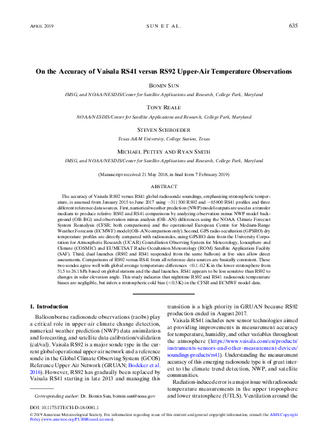Title
Authors
Published
by Journal of Atmospheric and Oceanic Technology (JTECH) at 2019-04-17
Abstract
The accuracy of Vaisala RS92 versus RS41 global radiosonde soundings, emphasizing stratospheric temperature, is assessed from January 2015 to June 2017 using ~311 500 RS92 and ~65 800 RS41 profiles and three different reference data sources. First, numerical weather prediction (NWP) model outputs are used as a transfer medium to produce relative RS92 and RS41 comparisons by analyzing observation minus NWP model background (OB–BG) and observation minus analysis (OB–AN) differences using the NOAA Climate Forecast System Reanalysis (CFSR; both comparisons) and the operational European Centre for Medium-Range Weather Forecasts (ECMWF) model (OB–AN comparison only). Second, GPS radio occultation (GPSRO) dry temperature profiles are directly compared with radiosondes, using GPSRO data from the University Corporation for Atmospheric Research (UCAR) Constellation Observing System for Meteorology, Ionosphere and Climate (COSMIC) and EUMETSAT Radio Occultation Meteorology (ROM) Satellite Application Facility (SAF). Third, dual launches (RS92 and RS41 suspended from the same balloon) at five sites allow direct assessments. Comparisons of RS92 versus RS41 from all reference data sources are basically consistent. These two sondes agree well with global average temperature differences <0.1–0.2 K in the lower stratosphere from 51.5 to 26.1 hPa based on global stations and the dual launches. RS41 appears to be less sensitive than RS92 to changes in solar elevation angle. This study indicates that nighttime RS92 and RS41 radiosonde temperature biases are negligible, but infers a stratospheric cold bias (<0.5 K) in the CFSR and ECMWF model data.
